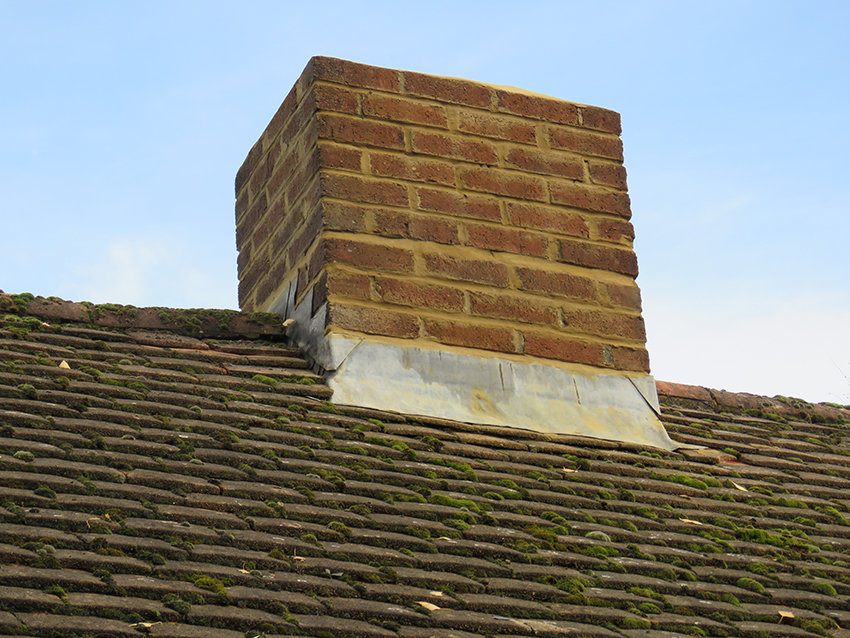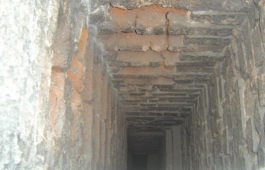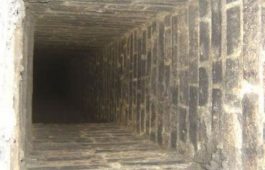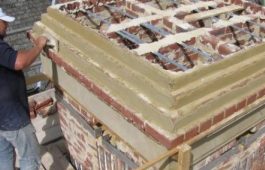Chimney Repointing
Chimney repointing is an important component of chimney maintenance and fundamental for keeping your chimney safe and in good working order. Like all the exterior brickwork of a building, chimney masonry can deteriorate over time. Sitting at height on top of the property a chimney is exposed to the elements; wind, rain, and temperature taking their toll. The mortar between the bricks will, over time, begin to ‘weather’ away. If left too long it will crack and water will be able to leak through.

In a chimney, water ingress can result in all kinds of problems. These include inefficient expulsion of the gases and damage to the interior of the home, to weakening the structure causing the chimney to collapse. All these problems can be very expensive to fix, so keeping the brickwork in good order is not only cost-effective but gives you peace of mind that your chimney is in a good, safe condition. In this article we look at chimney repointing as part of your chimney maintenance regime. We will look at what is involved and the benefits of having professional chimney repointing.
Do I need my Chimney Repointing?
Firstly, you need to know if work needs doing. If you have your chimney regularly maintained with a company like Billing Chimneys, this will be done for you. Anyone inspecting a chimney will be looking closely for visible signs that there may be issues. These issues include cracks in mortar or the bricks themselves. Change in the colour of the mortar is another indication that there could be an issue. Flaking of the mortar and spalling of the brickwork is also looked for. Spalling is where you see cracking or flaking on bricks.
Given that a chimney is high, inspections can be difficult, so methods other that a visual examination may be needed. Depending upon the position of the chimney in relation to the building, a ladder could be used. Modern technology can also be used, drones for example can aid the assessment of chimney masonry, allowing for close inspection without the need for climbing.
Signs on the inside of the building include water or damp in the roof space. There could be signs of damp on ceilings and discolouring of walls or wallpaper in rooms the chimney services or where the flue passes. Lower down the flue, there could be rust on the firebox.
Signs of problems with chimney masonry
- Cracks in mortar
- Discolouration in mortar
- Flaking mortar
- Spalling (flaking away) of bricks
- Rust in the firebox
- Damp in the roof space
- Damp ceilings and walls
- Discolouring of wallpaper
- Water ingress presenting on the register plate or within the fire recess
What is the chimney repointing process?
The first thing to remember is that chimneys are high on a building, so anyone attempting to repair a chimney needs to be competent and aware that working at height can be dangerous.
The starting point in the repointing process is a close inspection of the condition of the bricks and mortar. This will ascertain the extent of the problem and if there are issues other than age, wear and tear, and weather that may have caused the damage. This will enable the job to be planned, what materials will be required and an approximate timescale.
The building as a whole will be looked at. Experienced chimney technicians will want to ensure that any new work blends in with the existing bricks and mortar, otherwise the finished job could stand out and look odd. Having professional chimney repointing will avoid pitfalls like this and ensure a complete job. Professionals will provide a report on what their inspection found. It will explain the chimney’s condition, what needs to be done and a close estimate of the cost. Having a good quality, professional job means the chimney will be good for at least another thirty years.
It is likely that scaffolding will be used for the technicians to work safely. Covers may also be required, depending upon what lies beneath the area where the work will take place.
Another important consideration is when to carry out the work. The weather can seriously affect the integrity of the mortar. If there is frost the mortar mix will not set properly. It will freeze and then crack and fall out. Similarly, if the weather is very hot, the mortar can crack. A competent contractor will have an eye on the weather forecast and work will not take place if the weather conditions threaten the quality of the finished work.
Once work commences, the old mortar is chipped away using a chisel. A small chisel will scrape away loose old mortar but a larger chisel, along with a hammer might be needed for tougher mortar that needs removing. Removing the damaged and old mortar exposes the brick ends and creates room for the new mortar. If any of the bricks have spalled, these will need replacing. This will be dealt with first. Before applying the new mortar, the area should be brushed of all dust. Any debris is cleared away and the existing mortar prepared to ensure the new mortar fixes well.
Once the chimney masonry has been prepared it is time to fill in the joints. The new mortar will be pressed into the spaces between the bricks called joints. The bricks need to be dry and the mortar of the correct consistency. Having the mortar too sloppy will make it difficult to use and too stiff will make a mortar prone to crumbling.
Appropriate mortar should be used, matching the existing pointing as much as possible. It’s usual with repointing to work from top to bottom. The horizontal, or ‘bed joints’ are filled first, then the vertical or ‘head joints’ are filled. To ensure a neat job, the mortar is left until almost dry then any excess mortar is brushed away.
When finished, the look created is down to the style of the building and ensuring the new work matches the existing brickwork. As well as the colour, the shape of the mortar should match the existing mortar. Achieving this in the repointing process is down to the skill and experience of the technician.
There is bespoke method of pointing called tuckpointing. This is a specialised method of repairing brick mortar and involves the illusion of narrowing of the joint. Here the mortar is matched to the bricks. Once applied, a groove is drawn centrally in the new mortar and a contrasting mortar is pressed, or tucked, into the groove. Your chimney repointing contractor will have discussed methods with you following their initial inspection.
A range of tools is needed when repointing brickwork:
- Mortar – (usually cement, lime, and sand)
- Cement mixer
- Covers
- Chisels
- Hammer
- Wire brush
- Soft brush
- Mortar board
- Trowel
- A pointing or mortar gun can also be used
What are the benefits of chimney repointing?
It is inevitable that over time the mortar of chimney masonry will deteriorate. A chimney top by nature is exposed as its job is to safely expel the gases caused by burning fuel. Weathering from wind, rain, and sleet will, over time, erode the mortar. Frost, especially if the bricks or mortar are wet, is a particular hazard. Cracks, leaks, and water damage in a chimney can cause a range of issues. The good news is a good chimney repointing job will last for many years, so it is a sound investment for the efficiency of the chimney and for chimney safety.
Professional chimney repointing can pay dividends. Once completed, you can be assured that the mortar of the chimney is sound and that water ingress via the brickwork has been eliminated.
A chimney is often part of the charm and character of a house. It stands out, people notice a chimney if chimney repointing has been done poorly, so a good quality repointing job adds to the aesthetic appeal of the property.
Finally, good chimney maintenance will ensure that your chimney works safely and is energy efficient providing that cosy warmth and ambience desired of the fireplace.
What about chimney repointing costs?
It is difficult to provide a ball-park cost. The cost of professional chimney repointing depends upon a range of factors. These include the size of property, the location of the chimney on the property, the age of the property and the existing condition of the chimney. The costs are generally made up of labour, materials, scaffolding, or a scaffold tower.
It is, of course, possible for DIY chimney repointing though you will need to be aware of the work involved and ensure your safety when working at height.
Your situation, and chimney, are unique to you so acquire a quote from more than one company. Providing quotations is part of the normal process for a contractor and they will know that customers have sought other opinions and costs. By obtaining quotes from reputable companies, you can be assured of a professional chimney repointing job that will last many years.
DIY chimney repointing vs. hiring professionals
For anyone considering undertaking their own chimney repointing it is important to take many factors into consideration. Carrying out this kind of work takes skill and expertise. Even mixing the mortar itself is important. Too strong a mortar can also damage the bricks. Any cracking in the mortar indicates that the mortar applied was too strong.
If you have experience in the repointing process, then DIY may be for you, but don’t forget, you will need to ensure your safety when working at height. The biggest plus is probably in cost. Depending upon the location of the chimney you will likely still need to hire scaffolding. You will need the correct tools and other equipment. The biggest saving is obviously on labour. Generally, professional chimney repair is carried out by at least two operatives to ensure safety. It would be wise to consider having help from a competent person if you intend to carry out DIY chimney repointing.
Whilst hiring professionals will cost more, there are a range of guarantees. The initial inspection will have identified all issues, for example, why water is getting in if it’s cause isn’t simply age or general weathering. The job will be carried out by technicians who are experienced and will match mortar, ensuring the job not only solves the issues you are having but is also aesthetically pleasing. Professionals have all the correct tools and will understand that the work needs to be carried out under the correct conditions.
What chimney maintenance will be needed after repointing?
If the repointing job has been carried out correctly, little maintenance will be needed. A good professional company will clean any loose mortar as soon as the mortar has gone off, leaving the bricks clean. Provided the correct mortar mix has been used and the work carried out under the right conditions the mortar will last in-situ for many years.
If you have a chimney that is in regular use on your property, then you should have a regular maintenance routine. Sweeping and an inspection will include an inspection of the condition of the brickwork that is open to the elements. Frequency of inspections will depend upon the amount of use the chimney gets. The location of the property and its position will have an impact on the amount of weathering it is affected by.
Chimney repointing on historic buildings
With all repointing, it is essential that the new mortar matches in colour the building’s existing mortar. When repointing a historic or listed building all repair and renovation work must be like for like, so any repointing must create the same finish as the rest of the brickwork. Care must also be taken to replicate how the mortar is applied. We have already mentioned tuck pointing but there are other styles which dictate the shape of the edge of the mortar.
Pointing Types
- Flush – The most common, creates a straight edge
- Keyed – A concave curve
- Tuck – Putty placed into a groove in mortar, created prior to the mortar setting
- Struck – Sloped with the top slightly further back than the bottom
- Overhand struck – Sloped with top slightly further forward than the bottom
- Beaked – Where an outward point is created
Pointing historic and listed buildings to the correct standard is a skilled job and it is recommended that this job is carried out by professionals such as Billing Chimneys.
Finding the right chimney repointing contractor
Engaging a professional chimney pointing contractor is the best way to ensure that the chimney repair is carried out correctly, ensuring the job will last for many years.
Like most jobs we need doing by others on or in our homes, we want to be certain that whoever we choose will do the job we want to a high standard and be good value for money. We want the job to go as smoothly as possible and the contractor to communicate well. One of the best ways is to seek recommendations, check independent reviews and look for professional qualifications and experience.
A good contractor will be happy to provide a quote and will be aware that you will be seeking quotes from other companies. A good contractor will be happy with that and not try to persuade you against this action.
A good contractor’s quote will be clear and concise, so you know exactly what will happen during the repointing process and the costs involved.
Check how much experience the contractor has. For example, Billing Chimneys are chimney specialists working in the trade for over forty years. And check other credentials, such as accreditations and membership of organisations that ensure quality of work. For example, Billing Chimneys is HETAS registered (Heating Equipment Testing and Approval Scheme). We are also members of NACE (National Association of Chimney Engineers) which was established to protect and guide consumers.
Chimney repair checklist
- Get recommendations
- Check if the contractor is insured
- Look at reviews
- How experienced are they?
- Check Credentials
- Get at least three quotes
- Ask for a written quote and read their terms and conditions
The right people for your job
Keeping your chimney well maintained is the best thing for your safety and the efficiency of your fire or appliance. It is also a prominent feature of your building so an integral part of its appearance. Keeping it in good condition is essential and chimney repointing, when it is required, is part and parcel of your chimney maintenance routine. Luckily, once a chimney has been repointed the work should last for many years.
Billing Chimneys are chimney specialists with over forty years of experience. We provide high-quality workmanship carried out by experienced technicians and are confident that we are competitive. With many happy customers we are a go-to company for when you need professional chimney repointing.





